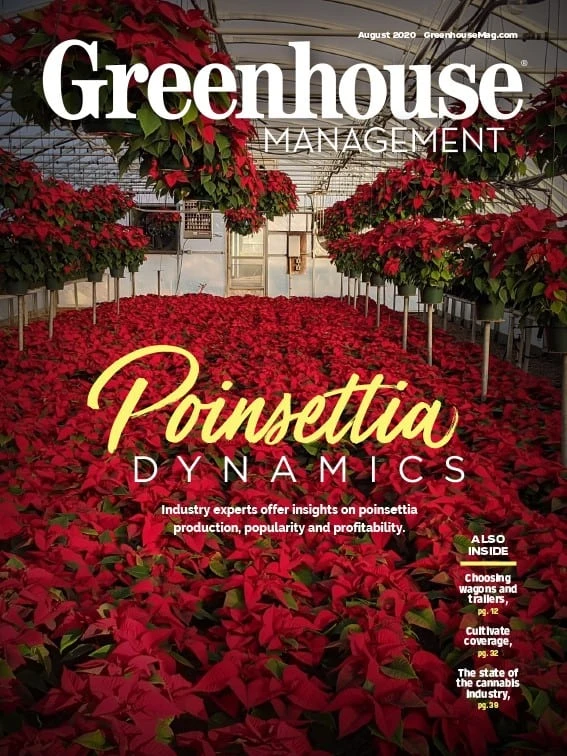

Plant handling is a major user of labor in the greenhouse and nursery industry. One to two cents is added anytime you handle a plant. For moving plants from a greenhouse to an outdoor growing area, wagons and trailers can be of considerable help. The following tips should help in making a selection:
Wagons
A wagon is generally considered a four-wheel drawn vehicle for carrying materials. There are many sizes from the small wagon that fits in the aisle between the benches to the tractor pulled farm wagon that is used for order picking in the nursery.
Select a size based on the materials to be carried and the restraints of the aisles or roadways. For retail sales, a small wagon that is easy to maneuver through the aisles of plants is desirable. Larger wagons that hold 10 to 15 flats or 80 to 120 1-gallon containers are convenient for picking plants from closely spaced growing beds.
The farm wagon running gear is standard for many nurseries throughout the U.S. The bed should be sized to fit the roadways and the tractors available. A common size is 8 feet wide by 16 feet long. It will carry about 500 1-gallon containers.
Pneumatic tires are better than solid or semi-pneumatic rubber as they cushion the load. The larger the diameter, the easier it is to move. Flotation tires should be used where the ground is soft.
The tongue can be fitted with either a handle or hitch. A clevis hitch is desirable for positive connection to the drawbar on the tractor. Multiple wagons can be pulled by connecting the tongue of one wagon to a hitch on the rear of the adjacent wagon.
A smooth deck surface such as sheet metal, diamond plate or plywood is best for loading and unloading containers. Be sure to protect any sharp edges.
To be able to carry more plants, especially flats and one-gallon containers, a wagon may be fitted with racks. Keep the height to within easy reach. Removable shelves allow for different size plants.
To eliminate one or more handlings, a wagon works well for transporting large movable production trays from the headhouse or greenhouse to an outdoor growing area (Fig. 1). Trays are rolled on rails onto the trailer and locked in place.
Where wagons will be used in tandem in narrow aisles, tracking wagons should be purchased. Both axles pivot and opposite ends of each axle are connected with a rod so that the trailer will follow the exact track of the towing vehicle. The turning radius is usually specified by the manufacturer.

Trailers
Trailers are usually considered to be a vehicle supported on one end by a towing vehicle, tractor or truck. Trailers are available in load-carrying capacities of 500 pounds to 20 tons or more. They can be designed for handling shipping carts that are loaded in the field and moved to the shipping area for loading onto the truck (Fig. 2). This can eliminate one or more handlings.
The bed should be sized for the equipment or material to be carried. Deck widths from 4 to 8 feet are available. Most manufacturers use steel decking. Diamond plate is good as it gives a rough surface for better traction. Plywood or planking is common on larger trailers. This should be treated for weatherability and have a good wear surface.
Small trailers are usually manufactured with the deck located just above the axle. This makes loading easier. The height may be between 14 to 17 inches, depending on the size of tires. Some trailers with wide decks usually have the wheels under the deck that raises it to 30 inches in height or more. To meet the maximum width requirements for vehicles, the wheels may be placed in wheel wells.
For highway travel, springs are desirable to provide a smooth ride. For slow speed farm use, springs are optional. Lights with flashers and direction signals are required for highway travel.
Trailers under 3 tons usually depend on the towing vehicle’s brakes to stop. Over 3 tons it is desirable to have brakes to assist the truck or tractor. Usually electric brakes are used. Electronic brake control that provides progressive pressure that prevents wheel lockup is available for some trailers.

Explore the August 2020 Issue
Check out more from this issue and find your next story to read.
Latest from Greenhouse Management
- Anthura acquires Bromelia assets from Corn. Bak in Netherlands
- Top 10 stories for National Poinsettia Day
- Langendoen Mechanical hosts open house to showcase new greenhouse build
- Conor Foy joins EHR's national sales team
- Pantone announces its 2026 Color of the Year
- Syngenta granted federal registration for Trefinti nematicide/fungicide in ornamental market
- A legacy of influence
- HILA 2025 video highlights: John Gaydos of Proven Winners





